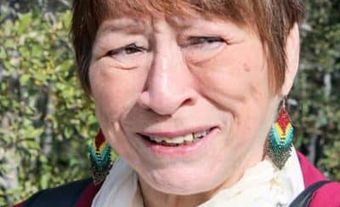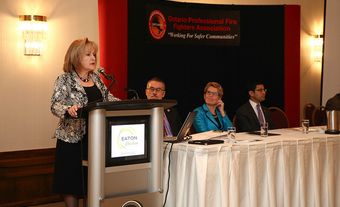Researching Barbara Hanley
Following her electoral victory in 1941, Hanley commented that she “want[ed] very little publicity.” History has seemingly obliged her — besides a brief article written by James Doyle in Ontario History in 1992 and a Laurentian University honours essay by Amelia Kretzschmar, it is difficult to find sources about Hanley’s career. As a result of several fires, no municipal records survive from Hanley’s time in office. However, her daughter, Ella Clifford Scutt, diligently recorded her mother’s municipal career and accomplishments in a scrapbook. This collection is arguably the largest single cache of documents on Hanley, excluding newspaper sources. In August 1967, Scutt donated the scrapbook to the Laurentian University Archives, where it is still housed today.
Early Life and Career
Daughter of Henry John Smith and Catharine Mitchell, Hanley was born 2 March 1882 in Magnetawan, Ontario, but was raised in the nearby town of Burk’s Falls.
After completing her secondary education, Hanley enrolled at the North Bay Normal School to become a teacher. Following graduation, she went on to teach at various villages in the area, including Trout Creek and Emsdale, before taking a teaching position in 1908 in Webbwood, a small town of around 600 people located approximately 70 km west of Sudbury, Ontario.
There, she met Joseph Hanley, a locomotive foreman for the Canadian Pacific Railway (CPR). The two wed on 27 August 1913 and, shortly after, adopted a baby girl, Ella, who would be their only child.
In addition to her teaching duties, Hanley founded the Webbwood Dramatic Society, staging plays, musicals and variety shows for the town. She was also elected to the Webbwood Public School Board in 1923, a position she held for 12 years.
Municipal Politics
Hanley was drawn into municipal politics because of the socio-economic conditions of the time. Webbwood was acutely affected by the Great Depression because the town’s major source of employment, the Abitibi Power and Paper Company mill in nearby Espanola, closed its doors at the end of 1929. Hanley’s main goal was to secure better public works and relief payments for the town. Consequently, she ran for office in 1935 and became Webbwood’s first female councillor.
The following year, Hanley ran for mayor. Her opponent was Robert E. Streich, who had previously served four terms as mayor between 1924 and 1934. In a close but decisive race, Hanley defeated Streich 82 votes to 69. The victory made her the first female mayor in Canada and the story was picked up by wire services around the world.
Hanley had to contend with the stereotypical attitudes of the day about women. After her victory, she was asked by one newspaper if she would continue with her housekeeping duties. She responded, “Yes, indeed. Webbwood is hardly a big enough place for me to give up my housework just to be mayor.” Her answer was reprinted in newspapers under the headline that “Ontario’s first woman mayor still does housework.” The newspapers’ emphasis on housework and the small size of the town seemed to downplay the significance of her achievement and remind readers that she was still just a “lady mayor.”
Mayor of Webbwood
During her inaugural council meeting on 19 January 1936, Hanley agreed to a motion by councillor Dr. K. Bromley to do away with the salary of mayor and council for the term in order to benefit the public. The motion passed unanimously and it was agreed that the forfeited salaries of $4 per month for mayor and $2 for councillors, a combined $200 for the year, would yield more than enough to purchase turkeys for the town the following Christmas.
In April 1936, Hanley was also re-elected by 5,000 delegates as the director of the Ontario Educational Association.
Hanley sought re-election as mayor in January 1937 and once again had to square off against Streich. This time around, Streich challenged Hanley on the basis of her sex and mayoral record. During a nomination meeting on 4 January, Hanley responded to his criticisms by stating, “I believe your two outstanding objections are: 1. That I am a woman; 2. That I am too generous with relief. I have no apology to make.” Hanley was re-elected that evening by a similar margin, defeating Streich 86 votes to 66.
In her inaugural meeting in 1937, Hanley instituted a new relief policy and transformed the entire town council into a relief committee. As part of this initiative she focused on projects that would enhance the town, such as the creation of vegetable and flower gardens.
Hanley encountered no opposition in her bid for her third term as mayor and was acclaimed on 27 December 1937. She was also acclaimed the following year for her fourth consecutive term as mayor.
During her third term in office, Hanley attended a university extension course in public administration, geared specifically for municipal officials in Ontario, at the University of Toronto from 25 to 29 April 1938. She was one of only two women registered among the 150 civil employees and administrators.
On 1 January 1940, Hanley outduelled CPR conductor George Mine and secured her fifth term as mayor.
The following year, the mayoral race was between Hanley and another female candidate, town councillor Mrs. Walter Blue. The fact that two women were competing for the mayoral seat in Webbwood generated considerable interest but Hanley insisted that she “doesn’t consider sex in municipal affairs.” Hanley reclaimed her position, besting Blue by a margin of 37 votes.
In 1942, she was acclaimed again. The following year, she defeated former councillor Mark Smith in her final bid as mayor. Hanley did not seek a ninth term and retired as mayor of Webbwood in 1944, replaced by C. Dwyer.
Although Hanley served eight consecutive terms as mayor, she was not quite ready to retire from municipal politics. In 1946, she was appointed town clerk, a position she held for four years before retiring from active municipal work.
Committee and Board Work
During the Second World War, Hanley was the chairman of the Webbwood Local Ration Board N-10 under the Wartime Prices and Trade Board.
In August 1946, the Sudbury District Home for the Aged was established and Hanley was appointed to its committee. Hanley had previously met with the Ontario Department of Public Welfare in 1943, lobbying for the establishment of a home for the aged in the Sudbury District. Her efforts as part of the committee led to the opening of Pioneer Manor in Sudbury in 1953.
Hanley died at the Sudbury Memorial Hospital on 26 January 1959 at the age of 76 and was buried in her hometown of Burk’s Falls on 29 January.
Legacy
Hanley’s tenure as mayor of Webbwood completed a long line of municipal service in her family. Her uncle, Samuel Kedey, had been mayor of the town of Arnprior in 1902 and her brother Robert served two terms as mayor of Cochrane, Ontario, from January 1934 to December 1935 and from January 1944 to December 1945.
Due to the significance of her accomplishment at the polls in 1936, the New York Sun included her on its list of Outstanding Women for that year. The list of 14 women included Lucy Moore, the youngest woman ever admitted to practise before the United States Supreme Court, and Wallis Simpson, future wife of King Edward VIII. Hanley was the only Canadian on the list.
Although Hanley was the first female mayor in Canada, others would soon follow. In 1951, Ontario could boast that it had four female mayors in power. Marjorie Hamilton was elected in Barrie in 1950, Grace B. McFarland was elected mayor of Leamington in 1951, Bernadette Smith was elected in Woodstock in 1951, and Charlotte Whitton was elected in Ottawa in 1951.
Although Hanley had blazed the trail for these women, her significance has often been understated or ignored. When Hamilton was elected as mayor of Barrie in December 1950, the Barrie Examiner wrote that she was the first female mayor in Ontario. A reader reminded the newspaper that this distinction rightly belonged to Hanley. Similarly, the 1985 edition of the Canadian Encyclopedia stated that Charlotte Whitton “became Canada’s first woman mayor in 1951” when she was elected to the city of Ottawa. It was later corrected to read that she was the first woman mayor of a major Canadian city.
As of 2015, Hanley was the longest-serving mayor of Webbwood and should be regarded as a pioneer in municipal politics and an icon of Canadian women’s history. Reflecting on her accomplishments in 1966, thirty years after she was first elected, the Sudbury Star wrote, “Many women have followed in the footsteps of Mrs. Hanley to head civic governments in Canada. But there is only one ‘first.’ ”

 Share on Facebook
Share on Facebook Share on X
Share on X Share by Email
Share by Email Share on Google Classroom
Share on Google Classroom






